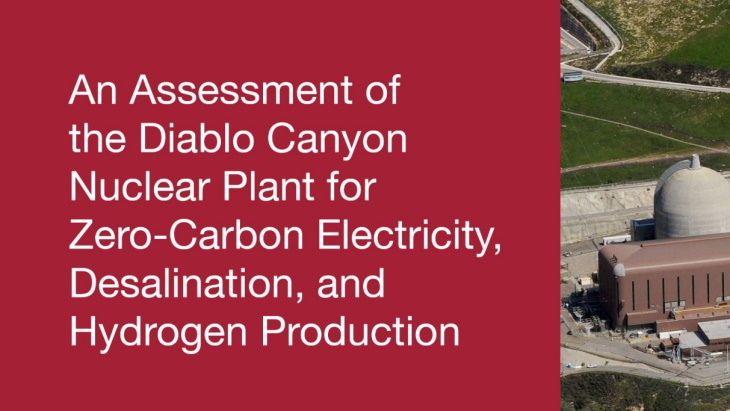Study assesses potential value of continued operation for Diablo Canyon

Diablo Canyon currently provides 8% of California's in-state electricity production and 15% of its carbon-free electricity production, but the state's Public Utilities Commission in January 2018 approved a multiparty settlement to fully and permanently shut the plant down when unit 2's operating licence expires in 2025. In its decision, the commission found that the plant was not cost effective to continue in operation, was not needed for system reliability, and that its value for reducing greenhouse gas emissions was "unclear", according to the authors of An Assessment of the Diablo Canyon Nuclear Plant for Zero-Carbon Electricity, Desalination, and Hydrogen Production.
"But in the intervening three and half years, several new developments have occurred," they note. These include: the signature of state legislation on zero-carbon generation and climate neutrality targets; recent studies highlighting the importance of always-available, non-weather-dependent generation capacity and reliable sources of zero-carbon fuels for hard-to-electrify sectors of the economy; blackouts and brownouts when electrical capacity has fallen below demand; mounting evidence of an increasing danger of severe water shortages; and state commitments to increase the share of land that is set aside for conservation purposes, limiting the amount of land available for energy production and other uses.
These developments led the joint study team of researchers from Stanford University and MIT to re-examine the potential value of Diablo Canyon in addressing these overlapping challenges. The team was assisted on hydrogen and multiple product research by Justin Aborn of energy analysis firm LucidCatalyst.
Delaying the retirement of the plant by ten years, to 2035, would reduce California power sector carbon emissions by more than 10% from 2017 levels and reduce reliance on gas, save USD2.6 billion in power system costs, and bolster system reliability to mitigate brownouts, the researchers found. "Even assuming rapid and unconstrained buildout of renewable energy, the continued operation of Diablo Canyon would significantly reduce California’s use of natural gas for electricity production from 2025 to 2035 by approximately 10.2 TWh per year. In doing so, Diablo Canyon would also reduce California carbon emissions by an average of 7 million tonnes (Mt) CO2 a year from 2025-2035," the report notes.
Operating the plant to 2045 and beyond could save up to USD21 billion in power system costs, potentially avoid the need to use save 90,000 acres of land for the siting of new solar photovoltaic capacity, and save up 50 Mt CO2 in cumulative emissions.
Multiple benefits
Diablo Canyon could be a "powerful driver of desalination to serve urban, industrial, and agricultural users," the study found. A desalination plant situated adjacent to Diablo Canyon would be able to augment fresh water supplies to the state as a whole and to critically under-served or overdrafted regions, at lower costs than existing or proposed desalination plants, while meeting environmental standards protecting marine life.
California "will likely need hundreds of millions of kilograms of hydrogen-based, zero-carbon fuels" annually to achieve a zero-carbon economy, the authors note. "The preliminary analysis here suggests that, with heat-assisted electrolysis, Diablo Canyon could produce 110 million kilograms of hydrogen annually at a cost of $2.01-2.46/kg. This is up to half less than the range of current costs of hydrogen produced from solar or wind power, while utilizing a small fraction of the space required for those other generation sources."
Hydrogen production at the Diablo Canyon site would also likely be cost-competitive with the hydrogen produced from natural gas with carbon capture, which is today's least expensive form of zero-carbon hydrogen production, they add.
The analysis also considered the potential to "repurpose" the nuclear plant to provide grid electricity, desalinated water, and hydrogen at the same time, and concluded that the production of these three products could "substantially increase" the value of Diablo Canyon by an amount equivalent to USD70/MWh, or even higher. "In a polygeneration configuration, the electricity output of Diablo Canyon plant could be directed to provide varying amounts of electricity to the power grid, desalination or hydrogen production, respectively, to maximise revenue, provide grid reliability, or meet other objectives, as needed," the report notes.
Repurposing the plant would not be without "many and considerable" challenges, including at the reinitiating the federal plant relicensing process. Chief among the challenges at the state level would be the need to obtain approval of a newly engineered water intake system as well as other approvals needed for the construction and operation of desalination and hydrogen production facilities, and supporting infrastructure. Stakeholders would need to be re-engaged, and "there will also likely be opposition in principle among some to the use of nuclear energy in any form, for any purpose," they note.
"While these challenges are substantial, so are the potential gains," they say. "This preliminary analysis is intended to allow policymakers and the public to consider weighing the benefits and tradeoffs associated with maintaining or rededicating Diablo Canyon in light of other new and urgent challenges that face California."
They conclude: "This study was not intended to be and should not be considered to be a definitive analysis of those benefits and tradeoffs. That will require further investigation. But the authors submit that the conclusions of this report present sufficient grounds for further study and debate by setting forth a prima facie case for extending the operations of the Diablo Canyon nuclear plant."
Funding for the project came from the MIT Center for Energy and Environmental Policy Research, the Abdul Latif Jameel Water and Food Systems Lab, the MIT Center for Advanced Nuclear Energy, the Rothrock Family Fund, the Pritzker Innovation Fund, The Rodel Foundation, Ross Koningstein, and Zachary Bogue & Matt Ocko.
Diablo Canyon's two pressurised water reactors are owned and operated by Pacific Gas and Electric Company.
The report can be downloaded here.









_66488.jpg)


